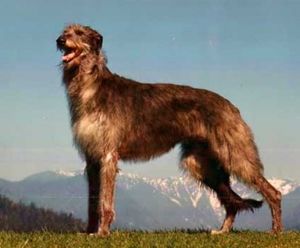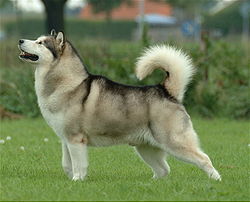 |
| Vital Statistics: |
| Place of Origin: Scotland |
| Group: Sighthound |
| Height: 28-32 in. |
| Weight: 75-110 lbs. |
| Life span: 9-11 yrs. |
| Trainability: high |
| Good with children: yes, but supervise due to large size |
| Good with other pets: High prey drive, may chase other animals |
What is the origin of the Scottish Deerhound?
Deerhounds are an ancient breed of dog. Scottish Deerhounds have been identified since the 16th century. At that time Deerhounds were exclusively owned by nobility. They are closely related to the Irish Wolfhound. Scottish Deerhounds are the Royal Dog of Scotland.
What does the Scottish Deerhound look like?
The Scottish Deerhound is a large, muscular dog, 28-32 inches tall and weighing 75-110 lbs. depending on gender. The head is long with a flat skull. Eyes are dark brown, brown or hazel with black rims. Ears are small, folded and dark colored. Nose is black. The mustache and beard are silky-haired. Tail is long and slightly curved, carried low. The coat is wiry, harsh and thick. Colors are shades of gray, blue-gray, brindles and rarely yellow or red fawn, sometimes with white chest and toes. Brush and comb the coat once or twice a week, stripping as needed.
What is the temperament of the Scottish Deerhound?
Scottish Deerhounds are gentle dogs, devoted to their family. They are easily trained with patience, making sure they have time-outs after 3 or 4 minutes of doing an exercise. Deerhounds are good with children but because of their size, need supervision with young children. They are friendly towards other dogs but may chase small pets as they are hunters. Deerhounds should have ong daily walks and runs in a secure area. As long as they have sufficient exercise they can live in apartments.
What is the Scottish Deerhound used for?
For centuries the Scottish Deerhound was used for hunting and as a companion and guard dog. They have a keen sense of smell and are good trackers. Some have competed in obedience and agility trials. Deerhounds are loving, loyal companions.
Possible Health Issues
Hypothyroidism, cardiomyopathy, arrythmia (irregular heartbeat), osteochondritis, cystinuria (genetic kidney defect resulting in producing kidney stones), panosteitis, cancers (particularly OSA), portosystemic liver shunt



